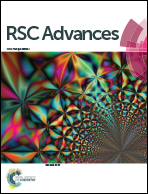p-MoS2/n-InSe van der Waals heterojunctions and their applications in all-2D optoelectronic devices†
Abstract
A library of two-dimensional (2D) semiconductors with different band gaps offers the construction of van der Waals (vdWs) heterostructures with different band alignments, providing a new platform for developing high-performance optoelectronic devices. Here, we demonstrate all-2D optoelectronic devices based on type-II p-MoS2/n-InSe vdWs heterojunctions operating at the near infrared (NIR) wavelength range. The p–n heterojunction diode exhibits a rectification ratio of ∼102 at Vds = ±2 V and a turn-on voltage of ∼0.8 V. Under a forward bias exceeding the turn-on voltage and a proper positive back-gate voltage, the all-2D vdWs heterojunction diode exhibits an electroluminescence with an emission peak centered at ∼1020 nm. Besides, this p-MoS2/n-InSe heterojunction shows a photoresponse at zero external bias, indicating that it can serve as a photodiode working without an external power supply. The as-demonstrated all-2D vdWs heterojunction which can work as both a light-emitting diode and a self-powered photodetector may find applications in flexible wear, display, and optical communication fields, etc.



 Please wait while we load your content...
Please wait while we load your content...